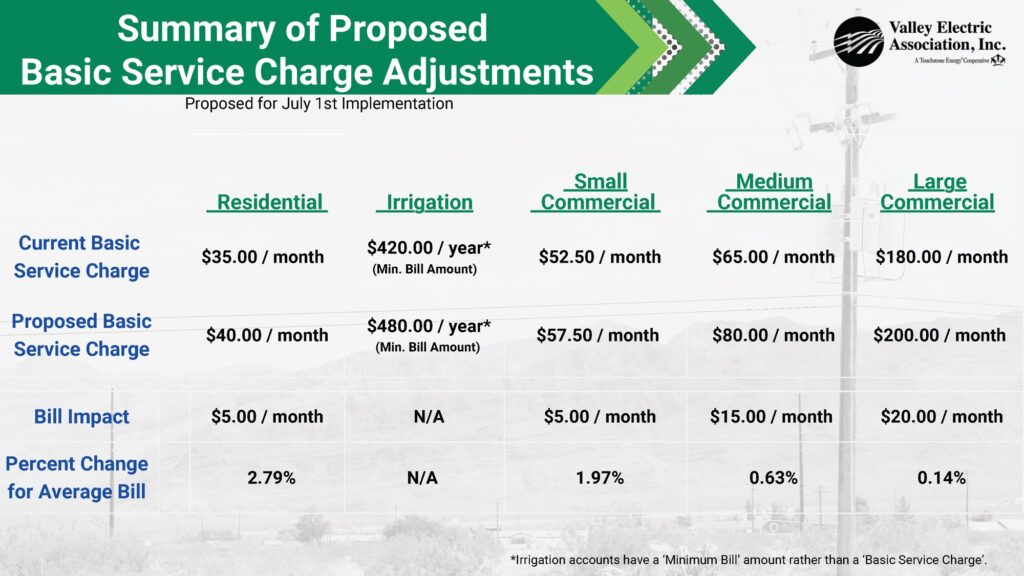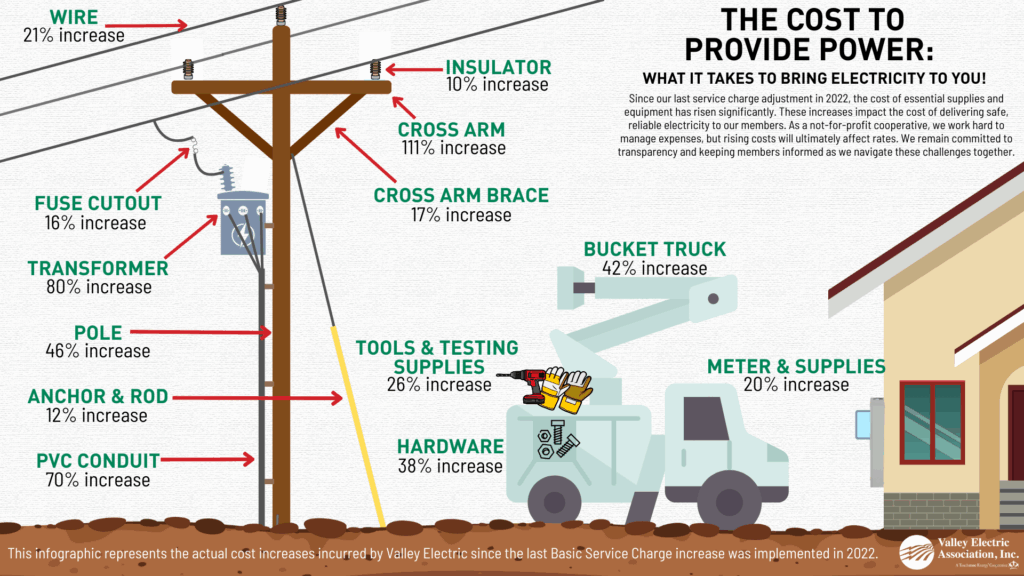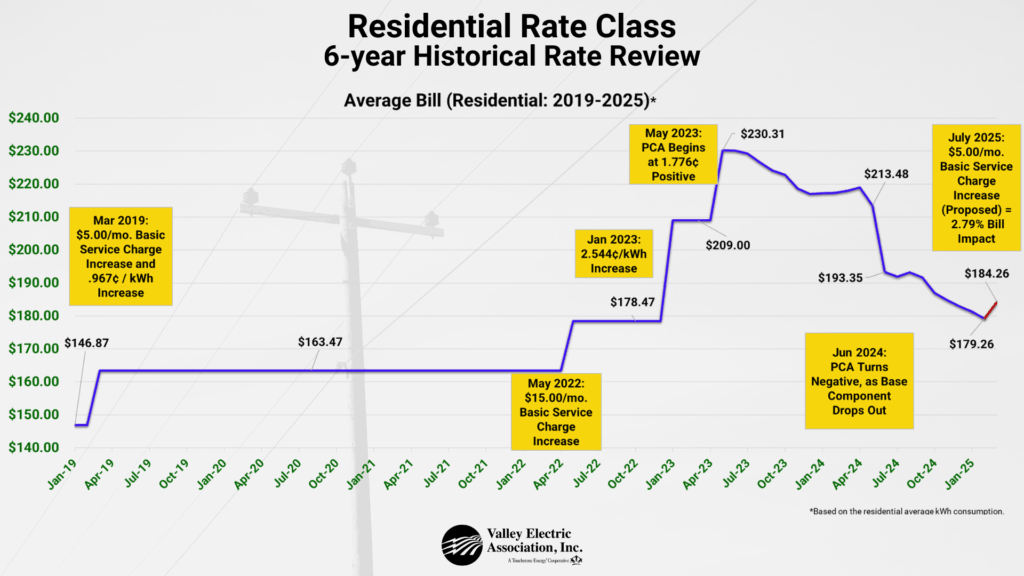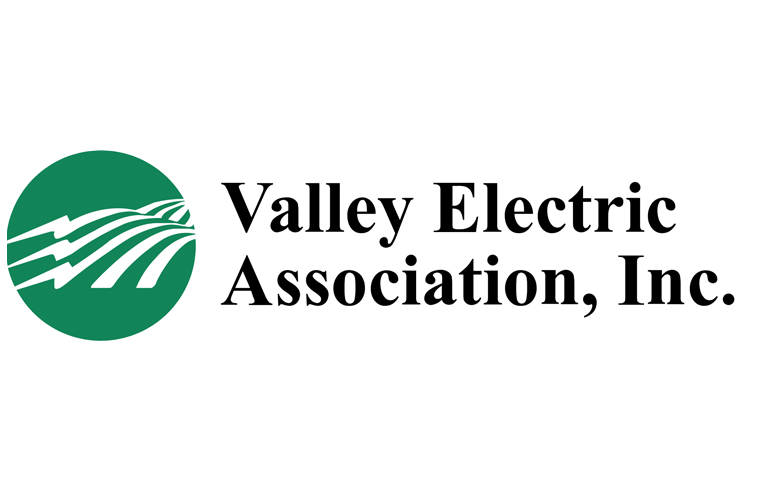Valley Electric Association (VEA) is preparing for a modest adjustment to its basic service charges, a move CEO Robby Hamlin and Board President Michelle Caird emphasized is essential for the cooperative’s continued strength and stability. Set to take effect July 1, the change will increase the basic service charge for residential customers from $35 to $40 per month, with corresponding adjustments for commercial customers based on their size and power usage. Small commercial customers will see a $5 increase, medium commercial $15, and large commercial $20.

Caird clarified that this is not a rate increase for electricity usage but specifically an adjustment to the basic service charge. “The rate per kilowatt-hour is not changing,” she explained. “In fact, the actual cost of power has gone down.” Hamlin reinforced that the service charge helps cover critical infrastructure costs—such as poles, wires, and transformers—that have seen dramatic inflation in recent years.
Providing a detailed breakdown, Hamlin and Caird pointed to a sharp rise in the cost of essential materials: cross arms are up 111%, poles have increased by 46%, and transformers now cost 80% more than they did in 2022. These are not minor expenses; they are high-cost items required daily to maintain the reliability of VEA’s electric service. “We’ve tried to absorb these costs for as long as possible,” Hamlin said, “but at some point, we have to pass on a portion of these increases to remain sustainable.”

Even customers who generate their own power through solar will see the $5 service charge increase, since the basic service charge applies universally across all member accounts. Caird and Hamlin stressed that this adjustment is purely about covering the fixed costs of maintaining and improving the electrical grid, separate from the cost of generating electricity.
While infrastructure costs have risen, there is a silver lining for members: the cost of power itself has decreased significantly. Hamlin explained that VEA’s Power Cost Adjustment (PCA) mechanism reflects this change directly in members’ bills. In January 2024, VEA’s power supply costs were about 15 cents per kilowatt-hour; today, due to favorable market conditions, members are paying closer to 11.5 cents per kilowatt-hour.
A major reason for this decrease is the surge of solar energy production across the western United States. During sunny, cooler months, there is often more power available on the grid than is needed, causing wholesale power prices to drop—sometimes even going negative, meaning producers pay utilities like VEA to take the power off their hands. Hamlin described how this phenomenon, along with improvements in the Western U.S. energy markets and recovery from previous natural gas pipeline disruptions, has helped drive down wholesale costs for VEA members.
While the cooperative has seen some relief in energy costs, the unpredictable nature of the market keeps VEA cautious. Hamlin emphasized that although no immediate future increases are anticipated beyond the July adjustment, the volatility of power markets, material costs, and global economic conditions prevent VEA from making long-term guarantees. “We do everything we can to maintain price stability,” Hamlin said, “but we’re subject to market forces just like everyone else.”
VEA’s leadership team has worked diligently to ensure members have plenty of notice and clear information about the upcoming changes. Over the past year, the board and management have carefully reviewed financial reports, market forecasts, and infrastructure costs. They chose to delay the adjustment by several months to provide time for more community outreach and discussion.
“This wasn’t a decision made overnight,” Caird said. “We’ve been studying the financials, reviewing graphs, asking questions, and working with staff for over a year. We pushed the implementation back from an earlier timeline (March) to make sure members had enough time to understand it. It’s about fairness and transparency.”
VEA presented the information at district meetings, ambassador meetings, and finance committee sessions. According to Hamlin, feedback from members who attended these sessions has been positive, with little to no pushback. Many members expressed understanding, particularly when they saw the data showing how material costs had skyrocketed and how VEA’s careful management had helped keep overall bills largely flat over the past three years.
Comparisons to larger utilities like NV Energy also highlight VEA’s careful stewardship. While basic service charges at NV Energy might appear lower, it’s important to consider the differences in population density. VEA’s service area is far more spread out, with only a few homes paying for each mile of power line, compared to hundreds of homes per mile in urban areas. When the total cost of electricity use is compared, VEA’s bills are still competitive and often very close to those of larger utilities, despite the challenges of serving rural areas.
Weather events also play a significant role in power prices. Caird noted that when high temperatures hit both California and Nevada simultaneously, as happened in 2022, demand spikes sharply across the western grid, causing open market power prices to soar. Thankfully, recent seasons have seen better conditions for energy pricing, helping VEA keep member costs low.

VEA’s approach moving forward is to monitor costs even more proactively and make smaller, more predictable adjustments as needed to avoid large, sudden increases. Hamlin compared it to the gradual cost-of-living adjustments seen in other sectors. “We would rather make modest changes that members can absorb over time than have to hit them with a huge increase all at once,” he said.
In line with their commitment to transparency, VEA plans an extensive outreach campaign to inform all members about the adjustment. In addition to information in the Ruralite magazine, the cooperative will run ads, post updates on the VEA website and social media platforms, and send an e-blast campaign to all members with an email address on file with the cooperative.
“We want our members to be well-informed,” Hamlin said. “We don’t want this to be something that surprises anyone.”
Ultimately, the leadership team at VEA believes the adjustment is a fair, necessary step to ensure the cooperative can continue providing reliable, affordable service well into the future.




